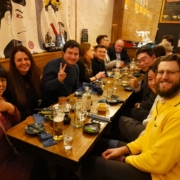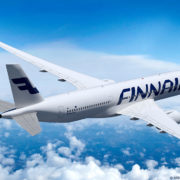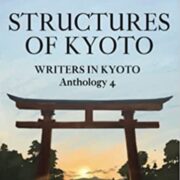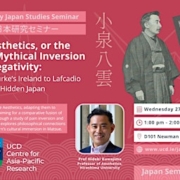Intercontinental ‘travels’ with my Granny’s postcards by Hew Prendergast
The early life of my Granny interested me for two main reasons. The first of them may soon facilitate my going abroad in a way I never once thought necessary. The second has already taken me via online ‘travels’ to countries far and wide. Despite much fascinating research involving medical education, international exhibitions in late nineteenth century Europe and the design of Japanese postage stamps, I still however cannot quite explain all the intercontinental links, let alone the manner in which I first came across them. In reading through this tale that starts with my Granny and stretches even to Brexit, perhaps a reader or two can throw some new light on these links, or discover lost nuances in translations from the Japanese that appear later.
My Granny was born in Dublin to the St Legers, a family of Norman and Anglo-Irish descent based for long in Co. Cork. If the name is somehow familiar it is perhaps through the eponymous horse race at Doncaster, the oldest Classic of the English flat-racing season; or, less likely, through the portrait of one John Hayes St Leger by Thomas Gainsborough that hangs at Buckingham Palace.
In the summer term of 1908 my Granny was 15, a pupil at the long-gone St Margaret’s Hall school on Mespil Road by Dublin’s Grand Canal. With an accomplishment unknown, much later, to her own grandchildren, she won as a prize for Theory of Music (so states a label inside the front cover) an undated gilt-edged edition of Elizabeth’s Barrett Browning’s Poetical Works. Its ‘prefatory memoir’ records the death of Elizabeth in 1861 when living in Florence with her poet husband Robert, and it reproduces words – in the tablet in the church where she is buried – the memory of “her golden verse linking Italy to England.”
My Granny has also long since died, spending most of her life in rural Co. Wexford, some of it in India, none in Italy and, as far as I know, showing no lasting interest in poetry. When I recently opened her prize book for the very first time I was in the process of sieving through passed-down belongings to decide what to keep and what not to, spurred on by the possibility of unearthing some forgotten gem or past family episode. But when, overleaf from the title page, three postcards came tumbling out, my surprise was as great as discovering my Granny’s putative poetic past. And so my ‘travels’ began.
The first card was easy enough to decipher. Alongside a stamp depicting George Washington were the boldly printed words ‘United States of America’, a rather faint St Louis postmark and an even fainter date of Jan. 7 1895. As if to confirm that my then just two year old Granny was not the recipient, the addressee was a Dr T.J. Chidley of 205 Great Brunswick (now republican Pearse) Street in Dublin whose western end runs past Trinity College. Dr Chidley, I knew, was no relation. However, the Boxwell family into which my Granny married in 1913 had in turn married into the Stokes family – and both of these produced lines of eminent medical doctors educated and working in Dublin. One Boxwell, Indian-born William, was President of the Royal College of Physicians of Ireland between 1937 and 1940; in the Stokes family, both also Williams, one succeeded his father in 1845 to become became Regius Professor of Physic at the University of Dublin while his own son in turn served as President of the Royal College of Surgeons in Ireland in 1886–1887.


The card sent to Dr Chidley from St Louis, Missouri.
Born in Glasnevin in 1862, Chidley registered for medical studies at Trinity College in 1885. Though these took place in Dublin, his qualifications were awarded under the aegis of the Royal Colleges of Physicians and Surgeons of Edinburgh and the Faculty of Physicians and Surgeons of Glasgow. The detailed entry in his Schedule for the Course of Study held in Edinburgh provided, I hoped, some sort of direct, explanatory link with my Granny’s medical relations. There, on the very last page and for his last year (1894), his teacher for the practice of surgery and operations is given as William Stokes, her uncle. One may easily imagine the physical act of Chidley handing over the postcard to Stokes, and thus into the wider family, but why would he do so?
The answer may lie in the advertisement on the other side of the card describing the virtues of antikamnia (meaning “opposed to pain”) and codeine tablets, a “combination particularly useful in La Grippe, Influenza and all Grippal conditions, Pneumonia, Bronchitis, Deep Seated Coughs, Neuroses of the Larynx, Etc, Etc.” The British and Colonial Agent for the tablets was given as a John Morgan Richards of Holborn Viaduct in London. Unusual for searches online, almost all mine for antikamnia homed in on just a single subject, the Antikamnia Chemical Company founded in 1890 in St Louis. In the long run its products actually proved fatal but that did not stop it making huge profits through – as the Wikipedia entry puts it – “clever advertising and marketing of the product targeting physicians, using physician testimonials and finding loopholes in the Pure Food and Drug Act of 1906.” This approach rings bells, seeming remarkably similar to that taken by Purdue Pharma in the USA, recently forced into bankruptcy over the opioid painkiller OxyContin, implicated in the deaths of hundreds of thousands. One could scarcely blame the newly graduated Chidley if he had indeed approached his most recent teacher for advice on such a dubious remedy in his own time.
None of this, however, makes any sense of the other two postcards whose hand-writing looked to me either Chinese or Japanese. What pointed to the latter was a minute Roman-scripted ‘Japanese Post’ on the printed stamp of one of the cards. How would I get any further on how they reached my Granny? A friend in Australia put me in touch with a professor of Japanese but, as she turned out to be too busy, I tried online with a site offering and looking for jobs. For the brief of translating the two postcards, offers and quotes poured in from countries across the globe but it was the solitary one from Japan itself that caught my eye. Kent, it later transpired, despite his fluency in English, had no idea until I told him that he shared a name with an English county but it was the sort of exchange that allowed a good relationship to build up between us. In the end he became an ally in trying to help me source the two cards.
But first he had to translate them. This was not easy. It was not due, he said, to the hand-written script which was clear enough but to its profound differences from the modern Japanese writing system. Kent struggled (“most of us don’t understand this at all”) and sought advice but eventually came back with the translations. What they revealed in the end brought me no nearer to any firm answer about their acquisition by my Granny but rather drew me into reading about aspects of Japanese culture and that country’s nineteenth century interactions with the West. The little I already knew stemmed from having curated, some years before, a collection of lacquerware that had been commissioned by the Royal Botanic Gardens, Kew in London. It had been made by John Quin, a member of the British Legation in Japan who, like so many of his peers at the time, was Irish. He had arrived in 1869 as a new recruit with the rank of 3rd Class Assistant and by 1888 had risen to become Consul in Nagasaki. Ill-health brought him back to Dublin where he died in 1897 and was buried in South Dublin’s Dean’s Grange Cemetery. The interest in lacquerware and the source tree of its resin exemplifies the European fascination with all things Japanese (japonisme) at the time – an interest that was reciprocated in full but how does it fit into the tale of these postcards?
The Japanese Post card, its design and 1 Sen denomination dating it (so I am told) to between 1885 and 1899, was written by a Mr Chobei Okamoto in Bessho Village, Otsu (a port on Lake Biwa) to Mr Shuzo Kumimara, a kimono dealer in Bungo Bashi-cho, Fushimi ward in the former imperial capital of Kyoto about 20 kilometres away. “Dear Sir,” it begins, “Please pardon my intrusion. As per my requests sent recently via Tsuji Yasaburō and the lady of the Hishikawa household, I am very keen for you to sell to me your Omoto [Japanese sacred lily] net cupboard. The fact is that I will soon be establishing a branch of Suruga-ya in Ōtsu, and intend to sell Yōkan [sweet bean cakes] there. That is why I want your net cupboard, for Suruga-ya. That is the situation, so I apologize for being so forward, but I hope you can comply with my request. As for the price, I will ensure there is some profit above whatever price you paid for it, so please sell it to me. Thank you in anticipation.
P.S. Sorry for the trouble, but I would appreciate it if you can let me know as soon as you have received this postcard.”


The postcard from Mr Chobei Okamoto to Mr Shuzo Kumimara
No trace has emerged of the kimono dealer but Mr Okamoto’s yokan-making enterprise not only has a well-documented heritage back to 1461 – and is widely listed as one of the world’s oldest commercial enterprises – but is still run by its founding family. Suruga-ya’s survival of a temporary closure in 2014 was even referred to in a Wall Street Journal report on the impact of Prime Minister Shinzo Abe’s economic policies. It now operates in Wakayama, about 100 kilometres south west of Kyoto, under the presidency of Mr Ryota Okamoto, the 23rd member of the family to do so. The company’s own website states that his ancestor Chobei went to the 1878 Exposition Universelle (World Fair) in Paris but I could get no further with discovering if he had also gone to later exhibitions. Perhaps I would have more luck with the second card which, as it turned out, points to such exhibitions as possible routes for these cards to have reached Europe.
This one was sent on 1 January of the 33rd year after the Meiji restoration of imperial rule, thus 1900. It is addressed to Mr Matsumoto Sahei in the coastal town of Komatsu Ryūsuke, about 170 kilometres north east of Kyoto, and is in the form of a New Year greeting. “I sincerely desire it to be an auspicious one for you,“ it begins. “I humbly hope that you all enjoyed a happy and healthy turn of the year. I am deeply grateful for the kind custom you favoured us with during the past year. I beg that we might be fortunate enough to receive the benefit of similar patronage in the year to come. Please excuse me for sending nothing but a brief expression of our best wishes to you at the time of this New Year’s festival. Fujita Yasuke, Nishi-iri, Gokomachi, Sanjō Street, Kyōto.”
One source in Japan told me that Mr Yasuke was an antique dealer and implied he had some business connections in Paris and Dublin. Otherwise I found nothing about him but his hope for “the benefit of similar patronage” suggests some previous exchange with Mr Sahei. He, by contrast, is far from invisible online. He was, and remains, a potter of renown whose works in the Kutani style of porcelain were being exhibited abroad – in Philadelphia in 1876, Chicago in 1893, Paris in 1878 and 1889 – and again in Paris at the Exposition Universelle in 1900, the year the post card was sent to him. Kutani porcelain traditionally came from Kaga, a town 20 kilometres down the coast from Komatsu. In the spirit of clearing – but not throwing – away one more possession I sent the card to where Kent had suggested, the Komatsu Hikiyama Exchange Centre, which in turn passed it to the City Museum. With Google’s help, I got a translation of their reply: “The cherry blossoms are in full bloom. Thank you for this time. When I delivered it to the museum, I was informed that it was registered as a historical document.” The card has thus returned to near where it was written 120+years ago, metamorphosing from a standard New Year greeting into a formal museum accession.


The postcard from Mr Fujita Yasuke to Mr Matsumoto Sahei
Did Mr Sahei go to those international exhibitions where his Kutani ware was on show? That I have been unable to confirm but he certainly went to a later one – the 1910 Exposition Universelle et Internationale de Bruxelles which ran from April to November. The evidence for this came in an extract sent to me from a Komatsu city magazine which, bizarrely, illustrated a post card that he himself wrote homewards that September.
Quite apart from exhibitors and exhibitions, there were also traders and a flourishing trade in Japanese art with Europe. The first individual to do so was a Mr Hayashi Tadamasa who, after attending the 1878 Paris Exposition Universelle as an interpreter – where, of course Mr Sahei also had his works on show – decided to stay on and start a dealership, importing and selling paintings, crafts and prints. These were not only highly appreciated by Western admirers but proved a driving force in the rise of japonisme. Some such admirers were actually based in Japan and prominent among them were doctors. William Anderson, a Londoner, moved to Japan in 1873 to become professor of anatomy and surgery at the Imperial Naval Medical College. On returning, he sold his huge collection of Japanese and Chinese paintings to the British Museum and later donated as many Japanese illustrated wood-block printed books to what is now the British Library. His contemporary Ernest Hart, an ophthalmic surgeon, also became an influential collector and connoisseur of Japanese art and was a founder member in 1891 of the Japan Society in London of which Anderson was the first chairman. As far as I can tell, and unfortunately for my ‘travels’, neither any Boxwell nor Stokes, nor indeed any Irish doctor of the time, had such interests in the Far East. Furthermore, unlike London, Dublin did not host Japanese medical students in the late nineteenth century.
So, I am left with speculation. Did Mr Kumimara, the kimono dealer, about whom I discovered nothing, go to Europe, taking with him his card from Mr Okamoto – who did go? On his own return to Japan did Mr Sahei somehow leave behind the New Year greeting he had received from Mr Yasuke? Or had the cards come with Mr Yasuke on some unspecified journey? Had any of them crossed paths with Dr Chidley, perhaps at some remove? Among the jostles of international exhibitions and exchanges at learned societies attended by enthusiasts of japonisme in all its forms, by doctors among them, and by Irish among other nationalities, it is not unreasonable – one hypothesis – to imagine the chance or intentional passing of postcards, possibly already wedged between pages of an unopened book, from one person to another.
One exhibition I learned about only recently, having explored all the other avenues of information, took place in 1907. Not only was it in Dublin but on a site (now Herbert Park in the city’s Ballsbridge area) just a short walk away from my Granny’s school on Mespil Road and just a year before she won her prize. Among the thousand or so exhibitors were four from Japan. Thanks to South Dublin Libraries Local Studies and their link to Dublin City Archive, a further link took me to Villanova University in Philadelphia where I could read in full the catalogue of the 1907 Irish International Exhibition. Three of the exhibitors were Ando & Co. of Nagoya and Tokio, K. Morota of (just) Japan, and Kojoro Suzuki of both Tokio and 23 Sandford Avenue, Donnybrook – a convenient few hundred metres from the site of the exhibition. The last exhibitor was Tsutsui & Co. and among their list of goods on show were so-called Japanese Postal Cards.

Extract of the catalogue of the 1907 Irish International Exhibition
So, after all my casting around for clues as to how my Granny obtained the Japanese cards, might the answer lie in a visit she – young, inquisitive, perhaps acquisitive too as a card collector – might have made to the exhibition? This really does look like the simplest, maybe even the most likely, explanation although it begs the question of how Tsutsui & Co. themselves obtained the cards and whether the transfer was somewhere in Europe or in Japan. Back at home or school my Granny would then have slipped the cards into her prize book of poems and put them alongside the advertisement for a bogus American pharmaceutical that – further speculation! – had been passed to her by medical relatives.
As for its original recipient, Dr Chidley, he makes just fleeting appearances in online searches. The 1903 Medical Register (now for UK registered doctors but then covering Irish ones too) lists him as living in Sandwich, Kent, but by 1905 he is back in Dublin working at the Rotunda (maternity) Hospital. He is absent, however, from the 1907 Medical Register and his last appearance both online and, it seems, in this world is in Maitland Cemetery in Cape Town. A gravestone there records his death in March 1913 and his title as Railway Medical Officer for South African Railways in the small town of Touws River, some 160 kilometres to the north east. A coincidence is that my Granny’s brother-in-law, Jack Boxwell, was by then living (married to a Stokes cousin) in Pretoria where he eventually became professor of classics and the translator into English of the first novel written in Zulu. Despite their thousand kilometres work-place separation, could a Chidley-Boxwell postcard transfer have occurred at some point? It seems no more unlikely than any other of my speculations. My Granny and Jack now lie close to each other in a south Wexford graveyard whose slight eminence gives a distant view of the Saltee Islands.
My Granny’s little collection has certainly raised a few questions. Others, readers of this perhaps, may one day work out the circumstances of two apparently unconnected Japanese post cards ending up in Dublin. In the meanwhile the first reason for my interest in her early life is rekindled. Brexit, 130 years later, has weakened the bond between the Anglo and the Irish, and indeed distanced the former from the Normandy origins of the St Legers, and prompted my application for Irish citizenship. I owe this possibility to my Granny. While I wait for a decision under Covid-19 restrictions I could do worse than read the book that, fitting for these times, Ernest Hart wrote in 1880 – The truth about vaccination: an examination and refutation of the assertions of the anti-vaccinators – and then, afterwards, place it on the shelf beside Poetical Works where these ‘travels’ began.
***
About the author
Article and research prepared by Dr. Hew Prendergast, a retired biologist whose working life was twice touched by Japan: firstly at the Royal Botanic Gardens, Kew where he curated the Economic Botany Collections which included the lacquer urushi collection made by John Quin (a book appeared on the subject in time with Japan 2001); and secondly when, as Director of Ashdown Forest in Sussex, he learned about the great Japanese interest in the Winnie-the-Pooh stories written by A.A. Milne which were set in and around the Forest. In 2005 he was invited to give talks in Wakayama about balancing the demands of tourism and conservation. Hew is happy to be contacted at hew.prendergast@btinternet.com.










